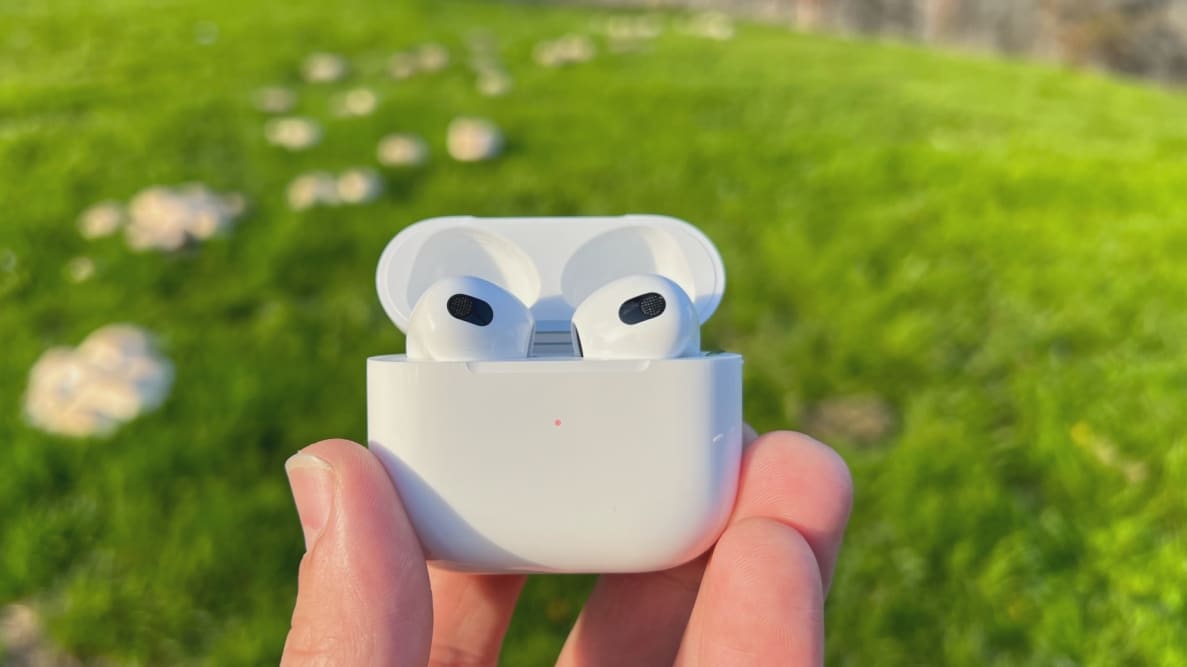Pros
-
Compact new design
-
Upgraded battery and features
-
Improved sound and great calling
Cons
-
No noise canceling
-
Still no way to customize fit
-
Upper register can sound tinny
It’s been a long wait between AirPods releases, with the Pro model launching in the before-times of October 2019. That’s a lifetime in wireless earbuds years, and both AirPods versions have shown their age. But that hasn’t stifled AirPods Pro fever. In fact, with a falling entry price and updates like Apple’s immersive Spatial Audio, it’s only the Pro’s battery (4.5 hours per charge with ANC, 24 hours with the case) that puts them behind current rivals.
The 3rd-gen AirPods have an answer there, offering an improved (though not revolutionary) 6 hours of playback time per charge, and 30 hours total with the case. They also borrow some of the Pro’s best traits, including a sleek new water-resistant design, control pads on the stems, and even Spatial Audio. And their premium build quality once again evokes Apple’s signature joy-spark. But without modern standards like noise canceling or even a way to customize the fit, the new AirPods’ premium price is tough to swallow.
About the AirPods 3 (2021)

Apple's new AirPods are sleeker, smaller, and come with multiple upgrades.
Here’s a look at the latest AirPods’ specs:
- Price: $179
- Battery life: up to 6 hours (5 hours spatial audio), 24 hours in charging case (30 total)
- Rapid charging: 5 minutes charge gets around 1 hour of playback
- Colors: White
- Ambient sound modes: None
- Speakers: Custom driver and amplifier
- Calling: Speech detecting accelerometer, beamforming microphones
- Connectivity: Bluetooth 5.0, Apple H1 Chip
- Audio codecs: AAC, SBC
- Dust/water resistance: IPX4
- Weight: 4.28 grams per bud, 37.91 grams charging case
-
Apple-only features: “Hey, Siri” control, one-touch pairing, Audio sharing, and audio swapping (with iCloud devices)
What we like
A sleeker design with much-needed upgrades
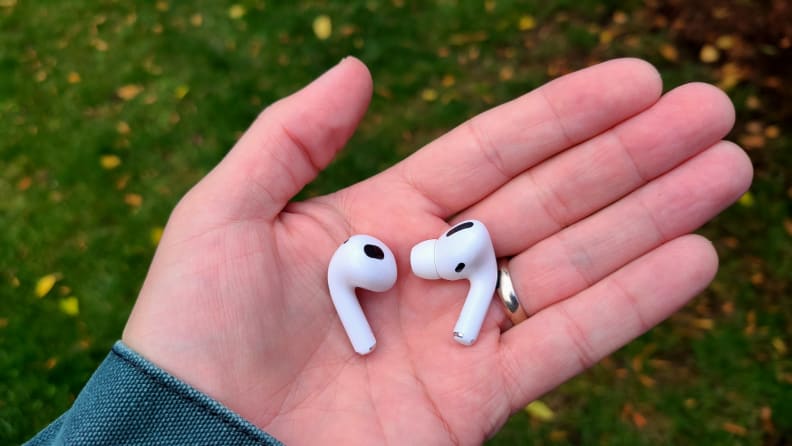
The AirPods (left) next to the AirPods Pro (right)
Most folks will have a hard time determining between the new AirPods and the AirPods Pro at a quick glance, and that’s by design. The new standard Pods share the same shorter stems bearing Force Sensor controls for intuitive play/pause, song skip, and calling up Siri (though, as with the previous AirPods, you can also just call her up with “Hey, Siri”).
Maybe just as important are the new interior bits; Apple has loaded up a healthy array of sensors and other hardware, trickled down from the Pro, to allow for some nifty new features. Those include Adaptive EQ to help improve audio performance by adjusting the sound in real-time, head tracking for Spatial Audio content (more on that below), as well as the ability to track your lost Pods with the same “proximity alerts” and deep dive Find My network as the Pro and Max models.
Also new is IPX4 water resistance (finally), which surprisingly includes both the buds and the case, as well as MagSafe charging so the case magnetically attaches to Apple charging mats.
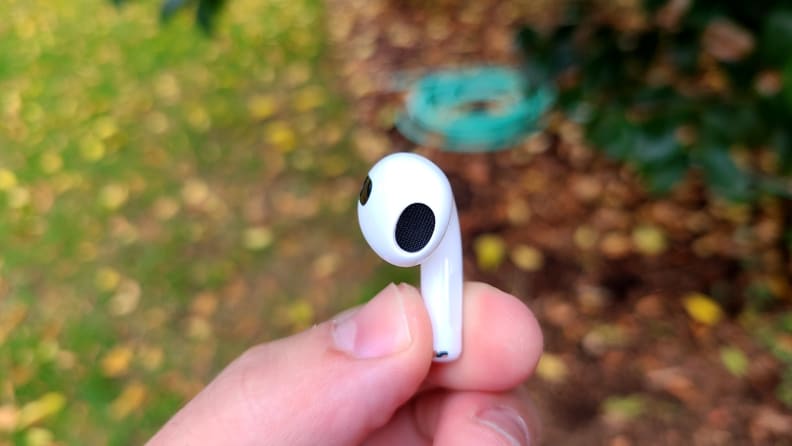
There are a lot of good changes to the new design, including water resistance and a new Force sensor on the stem, but they keep the same plastic ear tips.
What you won’t see here, to my chagrin, are any form of ear tips. This is likely to either irk or please you depending on your ear shape. For me, the magnetically attached tips in the AirPods Pro are a brilliant addition that makes them worlds more comfortable and also keeps them in place (not to mention its effect on sound quality). More than once in my testing, a big smile or other face movement has caused one of the tipless buds to dislodge or come precariously close.
But chatting with other folks, it’s clear that some prefer the plastic molded shape—some even suggesting it’s the only bud type that fits their ear properly. Whatever your preference, the lack of eartips seems more likely to be a calculated legacy rollover by Apple than an omission to save some bucks.
Improved sound quality (and Spatial Audio)
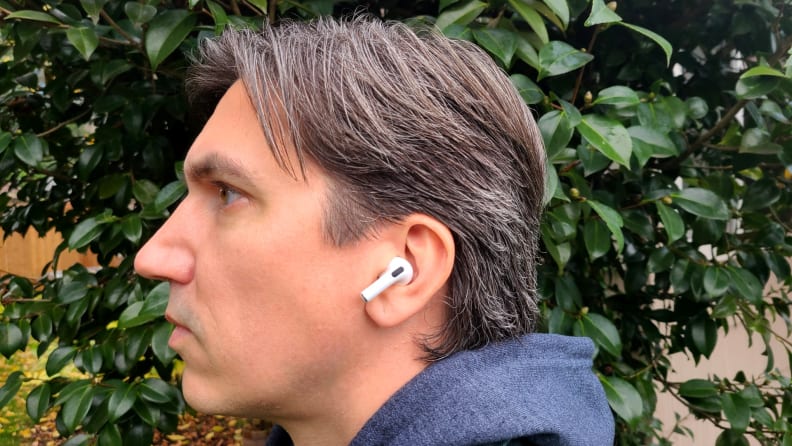
The new AirPods provide much better sound, especially for earbuds with an open-ear design.
While it’s been some time since I checked out the last-gen AirPods, it’s clear that the sound has improved for this model. There’s tighter, more accurate bass and pretty good instrumental detail and separation as well. They still don’t match the AirPods Pro in either detail or intimacy, nor do they offer the same vivacious sparkle as Samsung’s cheaper Galaxy Buds 2. What’s more, the upper register can get a bit sharp and tinny at times, which I’ll go into more later.
Some of this depends on how well the plastic shells fit in your ears, an inherent issue with omitting adjustable eartips. In general, the better the seal, the better the sound. Still, it’s impressive what Apple can do with its Adaptive EQ feature, engineering these odd plastic molds to output some solid quality from the new drivers. Details like a vocal reverb tail or the pound of a piano key come through with notably increased presence and precision.
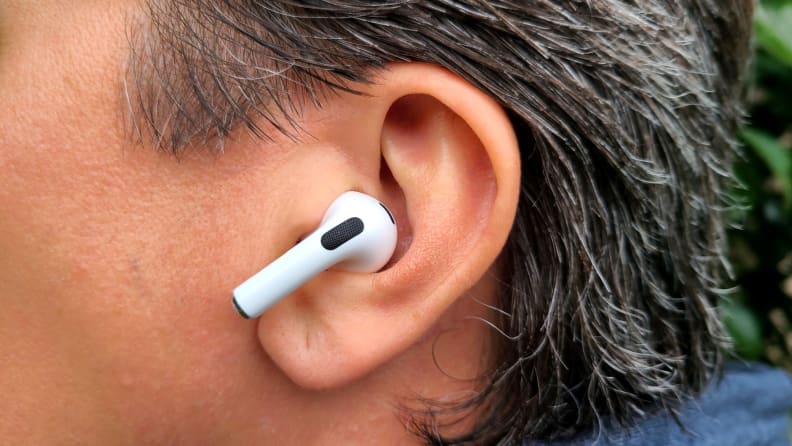
Spatial Audio is the coolest new feature, though it has limitations.
Spatial Audio is also pretty cool, though results vary and support is also pretty limited. While testing songs remixed in Dolby Atmos from Apple Music, the head tracking feature was the most intriguing. While “Let It Be” wasn’t particularly immersive when compared to the stereo track, turning my head to the left isolated Paul’s already stark and lonesome vocal to the right, while my left ear was free to explore the organ and horns in space. As those who’ve tried the feature in the Pro and Max headphones can attest, it can lend an exciting live feel to music.
Video content mixed in Dolby Atmos created more of the hemispheric immersion such 3D formats aim for; the tidal wave of bathwater that gushes toward Ant-Man in his first trial with the suit felt particularly enveloping, while bass boomed with some nice punch. Similarly, his ride through the swirling vacuum was quite effective, sweeping with little vortexes of sound. While I much prefer the AirPods Pro in such moments, Spatial Audio is a particularly cool upgrade.
All the conveniences of the Apple ecosystem
Those already neck-deep in Apple devices know the drill here, but if you haven’t yet experienced the simplicity with which all of Apple’s devices work in concert, it’s one of the biggest reasons to buy-in.
First, the fact that all AirPods (as well as Apple’s Beats buds) magically show up on your iPhone when you open the package is a nifty and convenient way to get started. Google and Microsoft have their own versions, but they’re not quite as simplified as Apple's battened down system.
The H1 chip, carried over from the previous AirPods, lets you seamlessly transition from Apple devices when logged into iCloud. It doesn’t always work perfectly for me, but it’s mostly accurate and a great function for working from home. Multipoint Bluetooth pairing, i.e. the ability to pair to two devices at once, allows similar functionality outside Apple’s circle, but you’ll generally only find it in pricier buds (Jabra’s Elite Active 75t being an exception), so it’s a nice AirPods incentive—as long as you’re using Apple devices.
A “Find My” feature is something you’ll find in plenty of earbuds these days, including top brands like Jabra and Samsung, but it’s generally confined to Bluetooth range (around 33 feet). For iOS 15, the AirPods Pro, Max, and AirPods (3rd gen) all get broader Find My functionality, letting you track with better accuracy and over longer distances. For me that mostly meant my devices (including the Beats Studio) in a cluster at my home address, but the buds followed along like the iPhone when we headed to the coast for the weekend. You can even get separation alerts so you’ll know when your buds go rogue.
And while I still wish Apple would add onboard volume controls, I concede that “Hey, Siri” makes this pretty easy to accomplish, alongside plenty of other functions. It’s especially fast with a newer iPhone. While you’re definitely paying for them, it’s nice to see all these AirPods Pro convenience features in the standard AirPods.
Improved battery life and good call quality
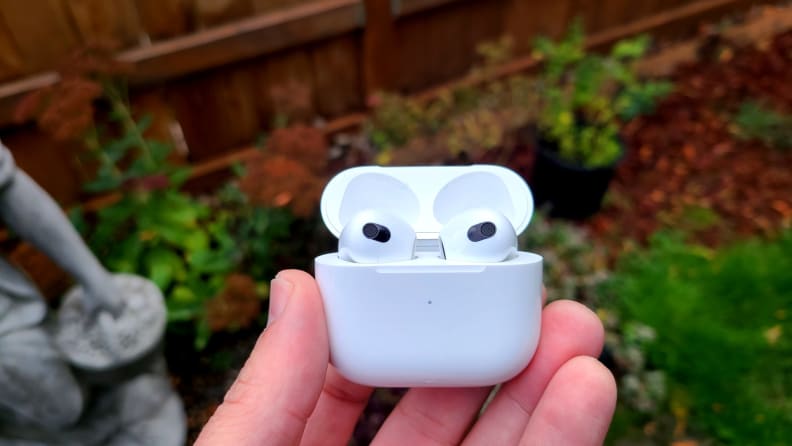
The battery life between the buds and case gives you as much as 30 hours before you'll need to plug in.
As mentioned above, the biggest knock on the AirPods Pro is their 4.5 hours of battery life. This is just enough to keep them from becoming a nuisance in most scenarios, but with many new buds arriving with 7-8 hours, and premium options like Sony’s WF-1000XM4 getting as much as 12 hours per charge (without ANC) it’s starting to look decidedly last-gen.
The new AirPods make things more competitive with 6 hours of charging, plus 24 hours in the case for a total of 30 hours off the grid. (I measured about 50% at 3.5 hours, so you may even be able to eke out a bit more.) With rapid charging, this still isn’t a make-or-break issue, but the more you have to charge your buds, the less life you can squeeze out of them in the long term. When it comes to battery life, bigger is always better.
As for call quality, while I wasn’t able to test in especially rough conditions, in the calls I made over the past few days the AirPods sounded generally as good to callers as the oft-lauded AirPods Pro. Apple has also added Spatial Audio to group Facetime calls to help delineate speakers.
What we don’t like
No Active noise canceling or transparency mode
The biggest features that didn’t make it to the AirPods (3rd gen) are the ambient sound modes we’re starting to see in even entry-level buds from many brands. Simply put, the ability to customize how much sound you let in or keep out with a simple tap of the controls is something we expect as standard in a pair of earbuds at this price. Apple's open design lets some sound in, but you can never block it out.
Apple hopes to make up for this with all the ecosystem extras mentioned above, but many of those can also be found in its last-gen Pods, which will sell for $129. Whether the lack of active noise cancellation or transparency mode are deal breakers is a personal decision, but in 2021, it’s disappointing to see them omitted at this price.
No ear tips or customization options
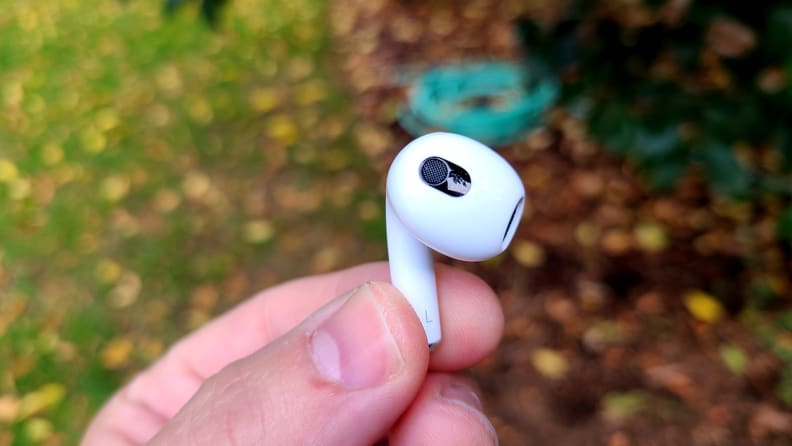
The new design is a hybrid between the previous AirPods and the AirPods Pro.
Fit is arguably the most critical aspect of wireless earbuds; companies have spent years trying to find new ways to make their buds more comfortable and stable—Jabra claims to have studied 62,000 ear scans for its Elite 7 Pro—and frankly, I’m not sure anyone has fully cracked that nut.
That said, Apple’s featherweight AirPods Pro are among the most comfortable I’ve tried. While the new AirPods are light enough to be comfy short term, after longer listening, the transition I've made from the new AirPods’ unyielding plastic shells to the Pro’s soft silicone has been a soothing relief, like going from a coarse sweater to a plush robe. Not to mention how much more stable the fit is. Plenty of heavier buds out there offer customization options that make them pretty comfy, too. I know the plastic molds are still desirable for some, but I can’t help but think Apple missed out by not adding some kind of customization here.
Sound quality still struggles at times
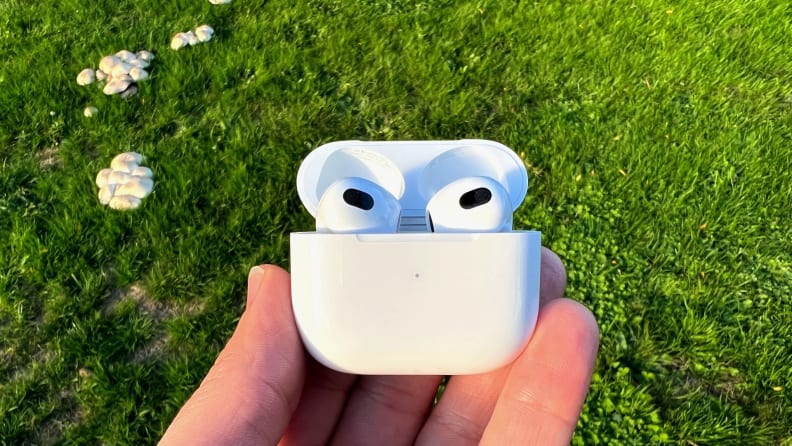
Apple pulls impressive sound quality out of the design, but depending on fit, some frequencies can be grating.
I’m picky about sound—a decade-plus listening to hundreds of headphones will do that to you. Still, my issue with the AirPods isn’t necessarily their quality, but their inconsistency for the price. They can sound quite good, but you'll get more depth, instrumental body, and accuracy from the AirPods Pro, and the same is true for lots of other headphones, some at lower prices (the Galaxy Buds 2 being the first that spring to mind).
Again, much of this comes down to how well the AirPods fit in your ears. I think Apple has done good things with Adaptive EQ (frankly, open earbuds should sound much worse), and Spatial Audio is a great perk. But without a proper seal, I find some sound elements like brighter vocals and particularly snappy drums and hot guitar distortion to be grating at times. Similarly, when listening to video content, effects like car crashes or explosions sometimes come off just too sharp. I think most people will generally be content with the sound, but it could be better.
Should you buy it?
Only if you can’t land the AirPods Pro
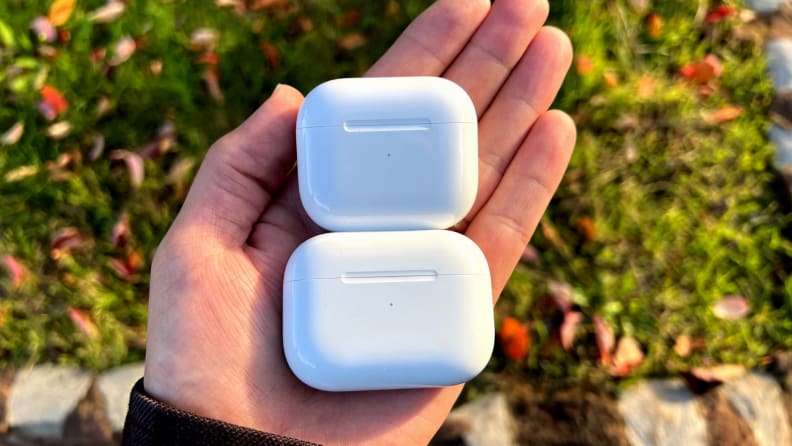
The AirPods (3rd generation) sit in their case above the AirPods Pro.
Apple’s latest take on the standard AirPods adds enough new features to make them much more appealing than their predecessors. You’ll get a more convenient and stylish design, better controls, improved (if still limited) sound quality with Spatial Audio, and more competitive battery life. Most important for their target buyers, the AirPods offer instant and seamless access to Apple’s ecosystem via the H1 chip, and even advanced tracking.
But Apple isn’t giving away these upgrades for free. While the third-generation are the best of the hard-plastic pods, they’re also the most expensive, and (at the time of writing) their cost is similar to sale pricing for the older AirPods Pro. Simply doing the math, the Pro are the pair to buy unless they just don't fit your ears—though once they’re only available with MagSafe charging at $250, that equation may change. At that point, the older AirPods may be the obvious entry point to Apple’s “walled garden” for most.
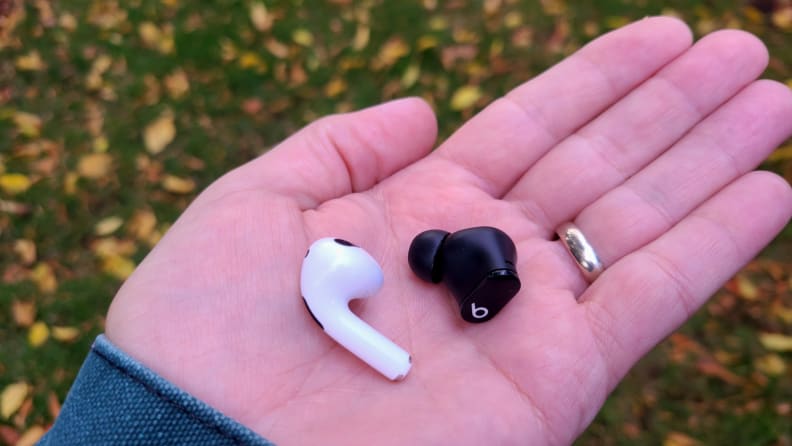
The new AirPods (left) next to the Beats Studio (right).
If you don’t demand the spoils of Apple’s H1 chip or Spatial Audio, there are also some brilliant alternatives. Apple’s own Beats Studio are the most obvious, offering a large swath of the AirPods experience (including “Hey, Siri” on-demand), along with decent active noise cancellation and transparency mode. Outside Apple’s world, Samsung’s Galaxy Buds 2 are incredibly capable buds with better overall sound, decent ANC, lots of features, and a stylish/compact design. And that’s just a taste of the wide variety of options.
Apple’s new AirPods are improved, and there are some compelling reasons to look their way—especially if the price drops by $20-30. But there’s no doubt that these buds feel capped by the very nature of Apple’s tiered structure; while many mid- and entry-level buds are adding features like ANC at lower pricing, the standard AirPods don't fully rise above their stature. If you want the best Apple buds for your money, grab a pair of AirPods Pro on sale—while you still can.
Meet the tester
Hailing originally from Montana, Ryan parlayed his time working as a musician and audio engineer into a career in digital media in 2012. Since then he's had extensive experience as a writer and editor, including everything from op-eds and features to reviews on TVs, audio gear, smart home devices, and more.
Checking our work.
Our team is here to help you buy the best stuff and love what you own. Our writers, editors, and experts obsess over the products we cover to make sure you're confident and satisfied. Have a different opinion about something we recommend? Email us and we'll compare notes.
Shoot us an email